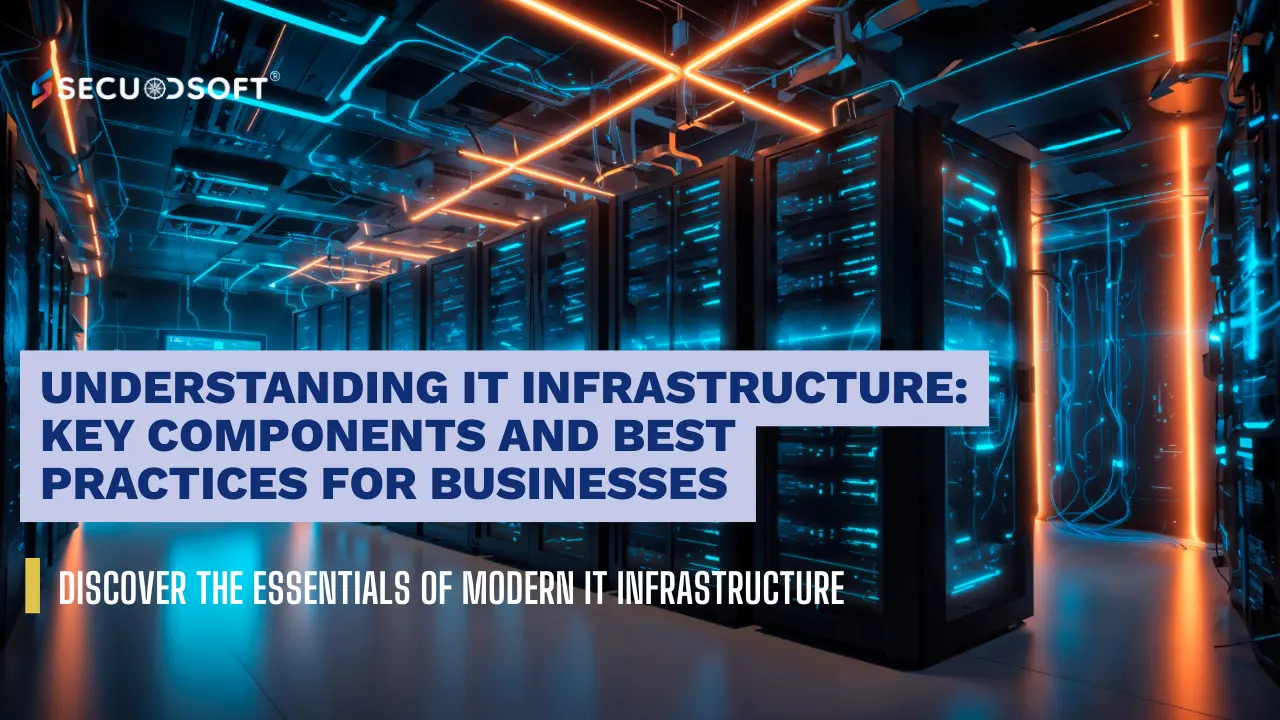
As businesses increasingly rely on technology, IT infrastructure has become the foundation that supports daily operations, growth, and innovation. From small startups to global enterprises, a robust IT infrastructure ensures that systems run smoothly, data remains secure, and services remain accessible and efficient. Understanding the components, types, challenges, and best practices for IT infrastructure is essential for any business looking to stay competitive and responsive to change.
In this blog, we explore the fundamentals of IT infrastructure for businesses - including its definition, main types, key components, best practices, challenges, and the critical role infrastructure plays in supporting growth, security, and digital transformation. Discover how partnering with Secuodsoft can supercharge your IT setup for lasting success.
IT infrastructure consists of all the hardware, software, networks, and services that enable an organization’s IT environment to operate effectively. It provides the backbone for delivering IT services and running business applications. The infrastructure encompasses physical devices, cloud resources, network components, and management systems, supporting everything from file sharing and communication to data analytics and cybersecurity.
A well-designed IT infrastructure improves operational efficiency, increases productivity, supports digital transformation, and ensures robust data protection. It also promotes agility, allowing businesses to scale services quickly in response to changing demands.
Businesses can deploy IT infrastructure in various forms depending on their needs, scale, and preferred operating models:
This setup relies on physical servers, storage devices, and networking hardware located within the organization’s premises. On-premises infrastructure allows for custom configuration and complete control over security but requires significant investment and ongoing maintenance for upgrades, cooling, and power.
Cloud infrastructure provides virtual IT resources via the internet, including servers, storage, applications, and network tools. Cloud service models include:
Cloud infrastructure supports scalability, flexibility, and cost-efficiency, allowing businesses to pay only for what they use and adapt quickly to market changes.
Hybrid infrastructure blends on-premises and cloud resources, offering the best of both worlds. Businesses can keep sensitive data on local servers while leveraging the scalability and flexibility of the cloud for other workloads.
Hyperconverged infrastructure combines compute, storage, and networking into a single, integrated solution managed via centralized software, increasing operational efficiency and scalability.
A modern IT environment is built from several interdependent components. Here are the most crucial elements:
Optimizing IT infrastructure requires a strategic approach, incorporating industry best practices to maximize performance, security, and cost-efficiency:
Automate routine maintenance, backups, updates, and monitoring to minimize human error and downtime. Continuous performance monitoring helps detect issues early and enables proactive remediation.
Design infrastructure that grows with business needs. Modular components facilitate easy expansion, upgrades, and technology integration.
Apply layered security approaches, encrypt sensitive data, enforce strict access controls, and regularly test systems against vulnerabilities.
Set up automatic failover, data replication, and offsite backups to safeguard against data loss and ensure business continuity during failures.
Keep all hardware, software, and network devices updated to address vulnerabilities and improve compatibility with new technologies.
Maintain thorough records of configurations, processes, and workflows for easier troubleshooting, onboarding, and compliance.
Educate employees on IT policies, security protocols, and the latest technologies to reduce risk and maximize infrastructure value.
Even with best practices, businesses face several challenges in managing IT infrastructure:
Modern IT environments combine multiple vendors, platforms, and legacy systems, increasing complexity and requiring skilled management.
Cyber threats evolve constantly, making security a moving target. IT teams must continuously update their approaches to defend against breaches, malware, and insider threats.
As businesses grow, infrastructure must scale while integrating new applications and services seamlessly. Poor planning can lead to bottlenecks and performance issues.
Balancing performance, reliability, and security with budget constraints is an ongoing struggle, especially for small businesses.
Keeping up with regulations and maintaining audit trails to meet legal requirements (data privacy, industry standards) takes time and resources.
Unplanned outages, hardware failures, and data loss events can disrupt business continuity and damage reputation.
A strong IT infrastructure is essential for:

Secuodsoft empowers modern businesses to supercharge their IT infrastructure with intelligent solutions tailored for reliability, scalability, and security. As a leading technology company, Secuodsoft offers comprehensive services covering IT infrastructure management, cloud migration, network optimization, custom software, and end-to-end cybersecurity. Our CMMI Level 3 appraised team specializes in designing, implementing, and managing hybrid and cloud-native architectures that support automation, high availability, and business continuity.
By leveraging advanced technologies - AI, cloud, IoT, and cybersecurity: Secuodsoft accelerates digital transformation and creates robust, high-performance infrastructures for startups and enterprises across India and beyond. Whether scaling up legacy systems, reducing downtime, or navigating regulatory requirements, clients benefit from Secuodsoft’s personalized consulting, agile processes, and round-the-clock support. Supercharge your IT infrastructure with Secuodsoft to unlock efficiency, enhance security, and future-proof your business in the rapidly evolving digital age.
Understanding IT infrastructure - its components, types, best practices, and challenges—is critical for business leaders, IT teams, and stakeholders across every industry. A well-managed, secure, and scalable infrastructure empowers organizations to innovate, achieve strategic goals, and adapt in a rapidly changing digital world. As technology continues to evolve, businesses must invest in flexible infrastructure, continuous learning, and proactive management, ensuring systems remain resilient and ready for future opportunities.
Copyright ©2025 Secuodsoft. All rights reserved.